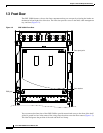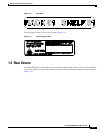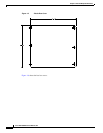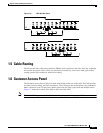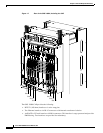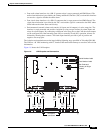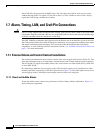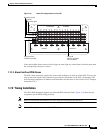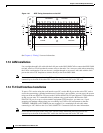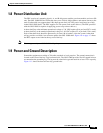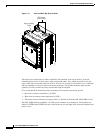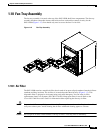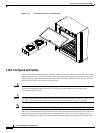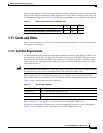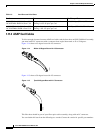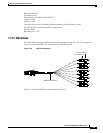
1-12
Cisco ONS 15600 Reference Manual, R7.2
Chapter 1 Shelf and Backplane Hardware
1.7.3 LAN Installation
Figure 1-10 BITS Timing Connections on the CAP
See Chapter 6, “Timing,” for more information.
1.7.3 LAN Installation
Use a straight-through LAN cable with the LAN port on the ONS 15600 CAP to connect the ONS 15600
to a hub, switch, or a LAN modem for remote access to the node. Use a crossover cable when connecting
the CAP to a workstation. You can also use a straight-through or crossover LAN cable with the LAN
port on the active TSC faceplate to connect directly to the local ONS 15600.
Note
Do not use the LAN port on the active TSC card for remote monitoring because you will lose
connectivity to the node if the other TSC card in the shelf becomes the active TSC card.
1.7.4 TL1 Craft Interface Installation
To open a TL1 session using the craft interface on a PC, use the RJ-45 port on the active TSC card to
access the system using a standard web browser. If a browser is not available, you can access the system
using one of the two EIA/TIA-232 ports on the CAP. Each EIA/TIA-232 port supports VT100 emulation
so that you can enter TL1 commands directly without using a web browser. Because the CAP
EIA/TIA-232 port is set up as a data terminal equipment (DTE) interface, you must use a 3-pair
swapping null modem adapter when you are working in a UNIX or PC environment so that the
TXD/RXC, DSR/DTR, and CTS/RTS pins are swapped. Use a standard pin D-sub cable when
connecting to a PC. Refer to the Cisco ONS SONET TL1 Command Guide for more information.
Note
Do not use the LAN port on the active TSC card for remote monitoring because you will lose
connectivity to the node if the other TSC card in the shelf becomes the active TSC card.
78511
16 15 14 13 12 11 10 9 87 65 43 21
BITS - B
BITS - A
EXTERNAL ALARMS
5
4
3
2
1
10 9 8 7 6 5 4 3 2 1
5
4
3
2
1
FRAME GROUND
64k
E1/T1
64k
E1/T1
+
OUT
+
IN
+
OUT
+
IN



